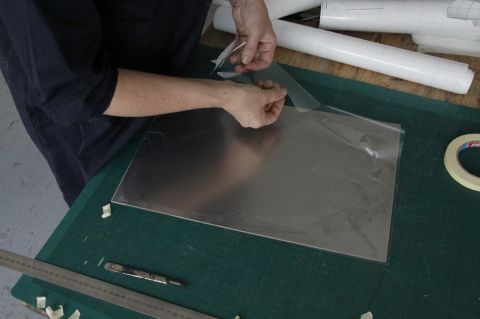Repetition.
Industrial mass production is all about repetition. As Jeanette Winterson wrote in her recent Guardian article on repetition in Lowry’s painting http://gu.com/p/3ggkk “At the loom, on the assembly line, on the track, the human being must perform the same task in the same way every working hour. The machine does not tire of this repetition, a repetition reinforced by the uniform lines of the mill windows, the identical terraced houses leading down to the factory.” The repetition of the bricks and windowpane grids in the façade of the Chisenhale building is a reminder of the repetitive labour that went on inside the factory.
In choosing to reproduce a version of the window in etching, I have launched myself into a mass production of my own. Printmaking has always been a way of mass-producing images, but in this piece I am not just creating an edition by repeatedly printing from one plate, but making a series of prints in which the production of the plates is also repeated over and over again.
When I conceived this idea, I assumed that this repetition of tasks would produce an efficiency that would enable me to complete a far larger body of work than I would usually manage in the time, but as I start with the first task of degreasing the plates I begin to realize quite how daunting the scale of this project is. Even with everything set up to clean and dry the plates en-masse, it takes about 5 minutes to degrease each plate. That is negligible if you are producing one or even a few plates, but I have to produce 64 plates to represent the 77 in the window (the unbroken panes can be made with blank plates, used more than once). I do some mental arithmetic and realize that it will take me about five and a half hours of continuous labour just to degrease the plates. This is only the first of many stages required to get an image printed from the steel. At this point I decide I have to split the production into 3 parts like the window itself. There is a balance to be struck between the efficiency to be gained by repeating each task 66 times before moving on to the next and taking account of my human tendency to go mad with boredom and fatigue. So I start with the 21 plates that will represent the top section of the window.
Degreasing is satisfying. The chalk and ammonia make a white bubbling mixture that sweeps across the plate forming a pattern like those painted by decorators on the inside of windows. The plates emerge free of the oily substance that keeps them from rusting; clean and naked and vulnerable and ready to be bitten by the acid. I line them up on their corners against the studio wall to dry and then line them up again, edges touching, to spray the backs with enamel paint to stop the acid eating into the reverse of the plates.




